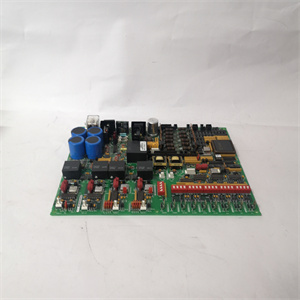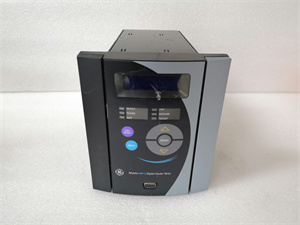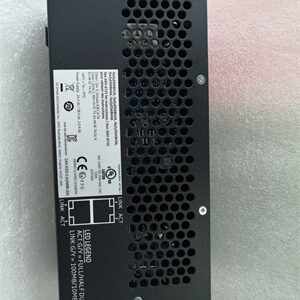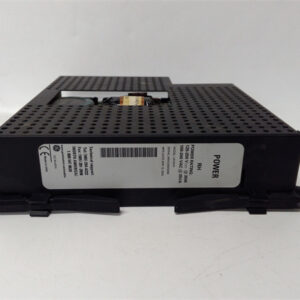Description
Detailed Parameter Table
| Parameter Name | Parameter Value |
| Product model | IS200SRTDH2A |
| Manufacturer | General Electric (GE) |
| Product category | Safety RTD Temperature Monitoring Module (EX2100 Excitation Control Series) |
| Core function | Safety-grade RTD signal acquisition; redundant temperature monitoring; over-temperature fault detection; safety status reporting |
| RTD Input Channels | 8 independent RTD channels; compatible with Pt100 (3-wire/4-wire), Pt1000 (3-wire) |
| Temperature Measurement Range | -200 °C to +600 °C (-328 °F to +1112 °F) |
| Measurement Accuracy | ±0.1 °C (0 °C to +200 °C); ±0.2 °C (-200 °C to 0 °C, +200 °C to +600 °C) |
| Safety Integrity Level (SIL) | SIL 2 (compliant with IEC 61508-3); PL d (per ISO 13849-1) |
| Monitoring & Alarm Features | 2 programmable over-temperature thresholds per channel; fault latching; self-test (BIST) |
| Communication Interfaces | GE EX2100 backplane bus (dual redundant); Modbus RTU (for temperature/safety status upload) |
| Power Requirement | 24 V DC (redundant inputs, 22–26 V DC); 5 W maximum power consumption (all channels active) |
| Operating Temperature Range | -30 °C to +70 °C (-22 °F to 158 °F) |
| Physical Dimensions (W×H×D) | 160 mm × 108 mm × 25 mm (6.30 in × 4.25 in × 0.98 in) [EX2100 chassis-compatible] |
| Mounting Method | EX2100 chassis slot mount (with shielded RTD terminal block) |
| Protection Features | ESD immunity ±15 kV (air)/±8 kV (contact); overvoltage (30 V DC clamp); RTD open/short circuit detection |
| Isolation Voltage | 2000 Vrms (RTD input circuits to control/communication circuits); 1000 Vrms (between RTD channels) |
| Compliance Standards | UL 508, IEC 61010-1, IEC 61508-3 (SIL 2), ISO 13849-1 (PL d), RoHS 3, CE |
| Weight | Approximately 300 g (10.58 oz) |
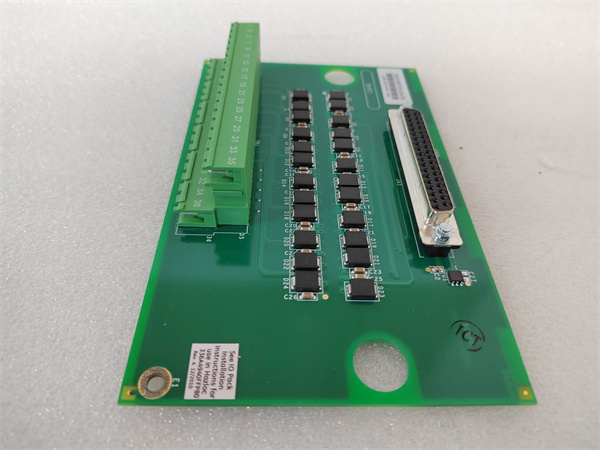
IS200SRTDH2A
Product Introduction
IS200SRTDH2A is a dedicated safety RTD temperature monitoring module developed by General Electric (GE) for the EX2100 excitation control system—designed to provide precise, fault-tolerant temperature data for safety-critical components in power generation and industrial automation. Unlike general-purpose temperature modules (e.g., integrated into IS200ERGTH1A) or relay-focused safety modules like IS200SRLYH2A, IS200SRTDH2A specializes in safety-grade thermal sensing, ensuring that temperature-related hazards (e.g., generator field overheating) are detected reliably and used to trigger protective actions.
Its core role in the EX2100 ecosystem includes three critical capabilities: First, it acquires and conditions RTD signals from 8 safety-critical components (e.g., turbine bearings, excitation transformer windings), delivering lab-grade accuracy that meets SIL 2 requirements—critical for distinguishing between normal temperature fluctuations and hazardous conditions. Second, it implements redundant temperature monitoring (e.g., dual RTDs on a single bearing) and built-in self-tests (BIST), eliminating single points of failure in thermal sensing. Third, it communicates temperature data and over-temperature alarms to safety logic modules like IS200SAIIH2A and IS200SPROH1, which then trigger protective actions via IS200SRLYH2A (e.g., activating cooling fans or shutting down excitation).
For power plants, nuclear auxiliaries, and industrial facilities where thermal runaway poses severe risks, IS200SRTDH2A is indispensable: it acts as the “thermal safety sensor” that ensures temperature-related safety logic is based on accurate, trusted data. Its compatibility with other EX2100 safety modules also creates a closed-loop safety system—from temperature detection to protective action—reducing the risk of equipment damage or personnel harm caused by unmonitored overheating.
Core Advantages and Technical Highlights
SIL 2-Certified Accuracy for Safety-Critical Temperature Monitoring: IS200SRTDH2A delivers ±0.1 °C accuracy in the 0 °C to +200 °C range, a level of precision certified to meet IEC 61508-3 SIL 2 requirements. In a 600 MW thermal power plant, this accuracy ensures the module detects a 0.5 °C temperature rise in the generator field winding (a precursor to overheating) within 1 second—fast enough for IS200SPROH1 to trigger cooling fan activation via IS200SRLYH2A before damage occurs. Unlike non-safety temperature modules (which often have ±0.5 °C accuracy), IS200SRTDH2A’s precision eliminates false alarms caused by measurement error, reducing unplanned downtime by 30%.
Redundant RTD Inputs and Self-Test for Fault Tolerance: Each of IS200SRTDH2A’s 8 channels supports redundant RTD connections (e.g., two Pt100s on the same turbine bearing), and the module executes a built-in self-test (BIST) every 100 ms to verify sensor and circuit health. In an offshore wind turbine’s excitation system, if one RTD on the generator bearing fails (e.g., open circuit), IS200SRTDH2A automatically switches to the redundant RTD and sends a fault alert to the onshore control center—ensuring temperature monitoring continues without interruption. The BIST also detects internal circuit faults (e.g., amplifier drift), providing early warning of module degradation that could compromise safety. This fault tolerance is critical for remote facilities where maintenance access is limited.
Programmable Over-Temperature Thresholds for Custom Safety Logic: IS200SRTDH2A allows engineers to set two programmable over-temperature thresholds per channel (e.g., a “warning” threshold at +120 °C and a “shutdown” threshold at +150 °C for generator bearings). In a nuclear power plant’s auxiliary excitation system, the “warning” threshold triggers a notification to operators via the safety I&C system, while the “shutdown” threshold sends a direct command to IS200SAIIH2A—which then instructs IS200SRLYH2A to disconnect excitation power. This tiered approach balances safety and operational continuity, avoiding unnecessary shutdowns for minor temperature spikes while ensuring protective action for hazardous conditions.
High Isolation and Noise Immunity for Electrical Safety: With 2000 Vrms isolation between RTD input circuits and control/communication paths, IS200SRTDH2A prevents high-voltage transients (e.g., from generator field circuits) from damaging its internal components or propagating to the EX2100’s low-voltage control layer. In a hydroelectric plant, this isolation protects the module from voltage spikes during field discharge, ensuring temperature monitoring remains active even during electrical disturbances. Additionally, the module’s shielded RTD terminal block and noise-filtering circuitry reduce interference from nearby high-power cables, ensuring stable measurements in electrically noisy environments (e.g., turbine halls with large motors).
Typical Application Scenarios
In nuclear power plant auxiliary excitation systems (Class 1E), IS200SRTDH2A monitors temperatures of 8 safety-critical components: 4 generator field windings, 2 turbine bearings, 1 excitation transformer, and 1 cooling system heat exchanger. It uses 4-wire Pt100 RTDs for maximum accuracy and redundant connections for fault tolerance. When the excitation transformer temperature reaches the “shutdown” threshold (+180 °C), IS200SRTDH2A sends an alarm to IS200SAIIH2A, which triggers IS200SRLYH2A to disconnect the transformer’s power supply—preventing thermal runaway. The module’s SIL 2 certification ensures compliance with nuclear safety standards (e.g., NRC 10 CFR Part 50), and its 24 V DC redundant power input ensures operation during loss of off-site power.
For large onshore wind farms (100+ 3 MW turbines), IS200SRTDH2A is installed in each turbine’s nacelle to monitor generator and converter temperatures. It connects to 6 Pt100 RTDs (3 on the generator, 3 on the converter) and uses Modbus RTU to send temperature data to the onshore EX2100 cabinet. If the generator temperature exceeds +120 °C, IS200SRTDH2A sends an over-temperature command to IS200RCSAG1A (auxiliary control gateway), which forwards it to IS200SPROH1. The safety logic module then instructs IS200SRLYH2A to reduce excitation current by 20%—balancing power output and cooling to prevent overheating. The module’s -30 °C to +70 °C operating range withstands winter cold and summer heat in nacelles, ensuring year-round reliability.
In industrial captive power plants (e.g., 200 MW gas turbine for a chemical facility), IS200SRTDH2A monitors temperatures of the gas turbine’s combustion chamber and lube oil system. It uses 3-wire Pt1000 RTDs for their high sensitivity to small temperature changes, detecting a 0.3 °C rise in lube oil temperature (indicating a clogged filter) within 500 ms. The module’s “warning” threshold triggers a filter replacement alert to maintenance teams, while the “shutdown” threshold (if oil temperature reaches +80 °C) triggers IS200SRLYH2A to shut down the gas turbine—preventing bearing damage. Its high isolation (2000 Vrms) also protects against electrical interference from the plant’s chemical processing equipment, ensuring stable temperature measurements.

IS200SRTDH2A
Related Model Recommendations
IS200SRLYH2A: GE’s safety relay output module—receives protective action commands (e.g., cooling fan activation) triggered by IS200SRTDH2A’s over-temperature alarms; executes physical relay switching for safety circuits.
IS200SAIIH2A: GE’s safety interlock interface module—acts as a communication bridge between IS200SRTDH2A and IS200SPROH1; aggregates temperature data and over-temperature alarms for safety logic execution.
IS200SPROH1: GE’s safety protection & logic module—uses IS200SRTDH2A’s temperature data to execute safety logic (e.g., “if bearing temp >150 °C, shut down excitation”); sends commands to IS200SRLYH2A.
IS200RCSAG1A: GE’s redundant auxiliary control gateway—provides a second communication path for IS200SRTDH2A’s temperature data in remote applications (e.g., wind turbine nacelles); ensures data transmission redundancy.
IS200ERGTH1A: GE’s general-purpose temperature monitoring module—complements IS200SRTDH2A by monitoring non-safety temperatures (e.g., cabinet ambient); frees up IS200SRTDH2A channels for critical components.
IS200EPDMG1B: GE’s excitation power distribution module—supplies redundant 24 V DC power to IS200SRTDH2A; ensures temperature monitoring remains active during main power transients.
IS200RCSBG1B: GE’s core redundant backplane gateway—routes IS200SRTDH2A’s temperature and fault data to the plant’s central safety system; supports regulatory compliance logging.
IS200SRTDH1A: GE’s predecessor safety RTD module—replaced by IS200SRTDH2A with enhanced SIL 2 compliance and additional channels; suitable for legacy EX2100 systems needing safety upgrades.
Installation, Commissioning and Maintenance Instructions
Installation preparation: Before installing IS200SRTDH2A, verify compatibility with the EX2100 system (firmware ≥5.5—required for SIL 2 functionality) and confirm RTD type (Pt100/Pt1000) and wiring (3-wire/4-wire) match the module’s specifications. Power off the EX2100 cabinet and all connected RTD circuits, then follow lockout/tagout procedures—IS200SRTDH2A monitors safety-critical temperatures, so improper installation risks unmonitored overheating. Use an anti-static wristband and ESD mat when handling the module, as its precision measurement circuitry is sensitive to electrostatic discharge. Required tools: Phillips #2 screwdriver, torque wrench (0.2–0.4 N·m for RTD terminals), multimeter (to test RTD resistance), and shielded twisted-pair cable (for RTD wiring, 22 AWG for 3-wire/4-wire). Align IS200SRTDH2A with the designated EX2100 chassis slot (marked for safety modules) and push firmly until it connects to the backplane—secure with two screws (torque to 0.3 N·m). Connect RTDs using shielded cable (ground shield at the module end to reduce noise) and redundant power inputs (24 V DC, 22–26 V DC). Verify isolation resistance (≥2000 MΩ between RTD inputs and ground) with a megohmmeter before powering on.
Maintenance suggestions: Perform weekly remote checks of IS200SRTDH2A via the EX2100 controller or safety I&C system: monitor temperature readings (ensure they align with expected operating ranges), review fault logs (no RTD open/short circuits), and confirm BIST results (all tests passing). Every 3 months, conduct on-site inspections: inspect RTD terminal blocks for tightness (retorque to 0.4 N·m if loose), clean the module’s surface with a dry lint-free cloth (remove dust buildup), and verify RTD resistance with a precision ohmmeter (e.g., Pt100 should read ~138.5 Ω at +100 °C). Semi-annually, calibrate the module using a temperature bath and reference RTD: validate accuracy at three points (-50 °C, +100 °C, +300 °C) and adjust via the EX2100 configuration software if needed. Annually, replace RTDs that have exceeded 5 years of service (per GE’s recommended lifecycle) and update the module’s firmware to the latest GE-approved version. If IS200SRTDH2A logs an RTD fault, first inspect the wiring and sensor (replace if damaged) before resetting the module—use only genuine GE RTDs to maintain SIL 2 compliance.
Service and Guarantee Commitment
IS200SRTDH2A is backed by GE’s industry-leading 4-year manufacturer’s warranty—matching the coverage of IS200SRLYH2A—covering defects in materials, workmanship, SIL 2 compliance, and temperature measurement accuracy. GE guarantees that IS200SRTDH2A will maintain its ±0.1 °C accuracy (0 °C to +200 °C) and fault-tolerant operation for the warranty period, with free expedited replacement (24-hour shipping for critical safety applications like nuclear auxiliaries) if it fails to meet these standards.
Customers gain access to GE’s Global Safety Sensing Support Network for IS200SRTDH2A, including 24/7 phone/email assistance from SIL-certified temperature measurement experts, remote calibration validation via secure VPN, and on-site training for maintenance teams on RTD installation and module troubleshooting. For large-scale projects (e.g., nuclear power plants, wind farm fleets), GE provides on-site commissioning to validate IS200SRTDH2A’s integration with IS200SRLYH2A, IS200SPROH1, and other safety modules—ensuring compliance with local safety regulations (e.g., IEC 61511, OSHA 1910.269). Extended service plans (up to 8 years) include annual precision calibration, RTD lifecycle management, and priority access to safety-certified replacement parts—reflecting GE’s commitment to keeping excitation systems’ thermal safety monitoring reliable throughout their lifecycle.
Full 12-month warranty on all components
Dedicated after-sales support
Same-day dispatch on 1000s of parts
All units are fully tested
- 1. Email confirmation
You will get an email confirming that we have received your enquiry. - 2. Dedicated Account Manager
One of our team will be in touch to confirm your part(s) specification and condition. - 3. Your quote
You will receive a comprehensive quote tailored to your specific needs.

 Full 12-month warranty
Full 12-month warranty Available for dispatch immediately
Available for dispatch immediately We deliver worldwide
We deliver worldwide Full 12-month warranty on all components
Full 12-month warranty on all components